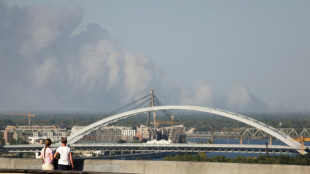Winds threaten to fuel huge Texas wildfire as blizzard hits California
Gusty weekend winds were threatening to worsen a million-acre wildfire that has already killed two people in the southern US, as a monster blizzard engulfed California's mountains Friday.
Fires are burning across northern Texas and neighboring Oklahoma, fueled by an unseasonably warm winter and ferocious winds.
After a slight dousing of rain that brought limited reprieve to firefighters on Thursday as they sought to get a handle on the out-of-control blazes, danger was forecast for Saturday.
"Critical fire weather conditions are expected to return midday Saturday and once again after sunrise Sunday," tweeted the National Weather Service in Amarillo, Texas.
Wind gusts up to 40 miles (65 kilometers) an hour could push the blaze into very dry grassland, spreading the boundaries of the fire even further.
The Smokehouse Creek fire started Monday and after merging with another blaze has now become the largest-ever wildfire in Texas at over one-million acres (over 4,000 square kilometers).
That makes it around the size of Rhode Island, or about three times the size of London.
Texas A&M Forest Service Fire Chief Wes Moorehead urged Texans to be careful over the weekend, when many celebrate Texas Independence Day on March 2.
"As firefighters continue to suppress active fires, we urge Texans to be cautious with any outdoor activity that may cause a spark," he said in a statement.
A 44-year-old truck driver died in an Oklahoma City hospital on Thursday, having been rescued near her smoke-engulfed truck in Smokehouse Creek on Tuesday, according to several local media.
While evacuations were ordered in some places, the body of an 83-year-old woman was found in the city of Stinnett, a Hutchinson County emergency services spokesperson told ABC News.
She also said about 20 structures in Stinnett had been razed by the fire.
A 120-year-old Texas ranch said it lost 80 percent of its 32,000-acre property near the area of the largest fire.
"The loss of livestock, crops, and wildlife, as well as ranch fencing and other infrastructure throughout our property as well as other ranches and homes across the region is, we believe, unparalleled in our history," the managers of Turkey Track Ranch said.
- -
Over on the US West Coast, the Sierra Nevada mountain range was getting walloped Friday by a blizzard that could dump as much as 12 feet (over three-and-a-half meters) of snow.
The life-threatening winter storm was bringing ferocious winds, with gusts as high as 145 miles an hour recorded at Palisades Tahoe in the northern part of the range.
There will be "whiteout conditions with near zero-visibility at times due to blowing snow," the NWS warned.
"Do not travel. If you must travel, have a winter survival kit with you. If you get stranded, stay in your vehicle."
Backcountry areas could also experience avalanches, the Sierra Avalanche Center warned.
Meteorologists say the weather system is particularly strong and very cold, coming in from the Pacific Northwest and ferrying a lot of moisture inland.
Courtney Carpenter of the NWS in Sacramento told the San Francisco Chronicle that a storm of this magnitude happens once every few years.
"This just happens to have the perfect combination of enough cold air and just the track of the storm that leads to a lot of snow flowing up into the mountains," she said.
While both winter storms and wildfires are naturally occuring and expected phenomena, human-caused climate change is exacerbating the strength and unpredictability of both.
A warmer atmosphere disrupts long-established weather patterns, bringing more intense periods of drought in some areas and heavier precipitation in others.
E.M.Hall--MC-UK



